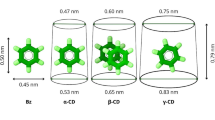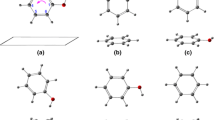Abstract
Host/guest interactions in the cyclophane-2/benzene system have been investigated by absorption and fluorescence spectroscopy in dichloromethane. The cyclophane serves as a host and the benzene as a guest. Absorption and fluorescence titration experiments are carried out by holding either the concentration of the host or guest constant while varying the concentration of the other component. When the concentration of benzene is kept constant, an isostilbic point at 288 nm is observed in the fluorescence spectral data, suggesting that only two absorbing species are present in equilibrium. Keeping the concentration of cyclophane-2 constant while increasing the concentration of benzene results in a hyposchromic shift of the emission peaks in the range 275–360 nm. The shift is attributed to interaction of the cyclophane with benzene. The average association constant of cyclophane-2 with benzene, K a = 425 ± 54 M−1, obtains from fitting the absorption and the fluorescence spectral data to the Bourson et al. equation using non-linear regression analysis.








Similar content being viewed by others
Abbreviations
- DCM:
-
Dichloromethane
References
Shibahara, M., Watanabe, M., Iwanaga, T., Ideta, K., Shinmyozu, T.: Synthesis, structure, and transannular π–π interaction of multilayered [3.3]metacyclophanes. J. Org. Chem. 72, 2865–2877 (2007)
Bartsch, R.A., Kus, P., Dalley, N.K., Kou, X.: A novel cyclophane–anthracene complex. Tetrahedron Lett. 43, 5017–5019 (2002)
Stetson, C.M., Nishikawa, S., Purkiss, D.W., Dalley, N.K., Bartsch, R.A.: Synthesis and evaluation of new ditopic cyclophane receptors for benzoic acid. J. Phys. Org. Chem. 18, 1107–1115 (2005)
Dalley, K.N., Kou, X., Bartsch, R.A., Kus, P.: Synthesis of new cyclophane host molecules and crystal structures of their compounds with hydrocarbon guests. J. Incl. Phenom. Macrocycl. Chem. 45, 139–148 (2003)
Dalley, K.N., Kou, X., Bartsch, R.A., Kus, P.: Synthesis of a new cyclophane host and crystal structures of its compounds with neutral guests. J. Incl. Phenom. Mol. Recogn. Chem. 29, 323–334 (1997)
Diederich, F.: Cyclophanes for complexing neutral molecules. Ang. Chem. 100, 372–396 (1988)
Saigo, K., Kubo, M., Lin, R., Youda, A., Hasegawa, M.: Synthesis and complexation of a novel cyclophane. Tetrahedron Lett. 26, 1325–1328 (1985)
Haeg, M.E., Whitlock, B.J., Whitlock, H.W. Jr.: Anthraquinone-based cyclophane hosts: synthesis and complexation studies. J. Am. Chem. Soc. 111, 692–696 (1989)
Denti, T.Z., Mordasini van Gunsteren, W.F., Diederich, F.: Computer simulations of the solvent dependence of apolar association strength: Gibbs free energy calculations on a cyclophane-pyrene complex in water and chloroform. J. Am. Chem. Soc. 118, 6044–6051 (1996)
Kind, C., Reiher, M., Roder, J., Hess, B.A.: A quantum chemical study on the stability of [3n]-allenophanes (n = 2−4). Phys. Chem. Chem. Phys. 2, 2205–2210 (2000)
Chang, C.E., Gilson, M.K.: Free energy, entropy, and induced fit in host-guest recognition: calculations with the second-generation mining minima algorithm. J. Am. Chem. Soc. 126, 13156–13164 (2004)
Jorgensen, W.L., Nguyen, T.B., Sanford, E.M., Chao, I., Houk, K.N., Diederich, F.: Enhanced view of structure and binding for cyclophane–arene complexes through joint theoretical and experimental study. J. Am. Chem. Soc. 114, 4003–4004 (1992)
Turker, L.: The tautomeric forms of a cyclophane system and some of their spectral properties: a theoretical study. Theochem 636, 133–141 (2003)
Ferguson, S.B., Seward, E.M., Diederich, F., Sanford, E.M., Chou, A., Inocencio-Szweda, P., Knobler, C.B.: Strong enthalpically driven complexation of neutral benzene guests in aqueous solution. J. Org. Chem. 53, 5593–5595 (1988)
Kunsagi-Mate, S., Szabo, K., Bitter, I., Nagy, G., Kollar, L.: Unexpected effect of charge density of the aromatic guests on the stability of calix[6]arene-phenol host–guest complexes. J. Phys. Chem. 109, 5237–5242 (2005)
O’Brien, M., Smalley, R., Amonge, A., Raber, S., Starosota, A., Buthelezi, T., Bartsch, R.A., Wegiel, M.: Spectroscopic properties of cyclophane/anthracene and cyclophane/9-fluorenone complexes in dichloromethane. Microchem. J. 80, 55–63 (2005)
Steed, J.W., Atwood, J.L.: Supramolecular Chemistry. Wiley, Chichester, New York (2000)
Falahatpisheh, M.H., Kerzee, J.K., Metz, R.P., Donnelly, K.C., Ramos, K.S.: Inducible cytochrome P450 activities in renal glomerular mesangial cells: biochemical basis for antagonistic interactions among nephrocarcinogenic polycyclic aromatic hydrocarbons. J. Carcinogen. 3, (2004)
Sanyal, M.K., Mercan, D., Belanger, K., Santella, R.M.: DNA adducts in human placenta exposed to ambient environment and passive cigarette smoke during pregnancy. Birth Defects Res. A Clin. Mol. Teratol. 79, 289–294 (2007)
Ludwig, R.: Calixarenes in analytical and separation chemistry. Fresenius J. Anal. Chem. 367, 103–128 (2000)
Castro, R., Davidov, P.D., Kumar, K.A., Marchand, A.P., Evanseck, J.D., Kaifer, A.E.: Inclusion complexation of cyclobis (Paraquat P Phenylene) and related cyclophane derivatives with substituted aromatics: cooperative noncovalent cavity and external interactions. J. Phys. Org. Chem. 10, 369–382 (1997)
Bourson, J., Pouget, J., Valeur, B.: Ion-responsive fluorescent compounds. 4. Effect of cation binding on the photophysical properties of a coumarin linked to monoaza- and diaza-crown ethers. J. Phys. Chem. 97, 4552–4557 (1993)
PCModel V9.0, Molecular Modeling Software, Serena Software, Bloomington, IN (2004)
Acknowledgements
This work was financially supported by the NSF-MRI grant-0421228 and the Materials Characterization Center at Western Kentucky University. CD and RG wish to acknowledge the KY NSF-EPSCoR Scholar Program, and the NSF-REU Grant EAR-035361 for support of their research. The research conducted at Texas Tech University was supported by Grant D-0775 from The Welch Foundation.
Author information
Authors and Affiliations
Corresponding author
Rights and permissions
About this article
Cite this article
Davies, C., Ren, L., Gustafson, R. et al. Molecular association of benzene with a new cyclophane receptor. J Incl Phenom Macrocycl Chem 61, 347–352 (2008). https://doi.org/10.1007/s10847-008-9428-2
Received:
Accepted:
Published:
Issue Date:
DOI: https://doi.org/10.1007/s10847-008-9428-2




